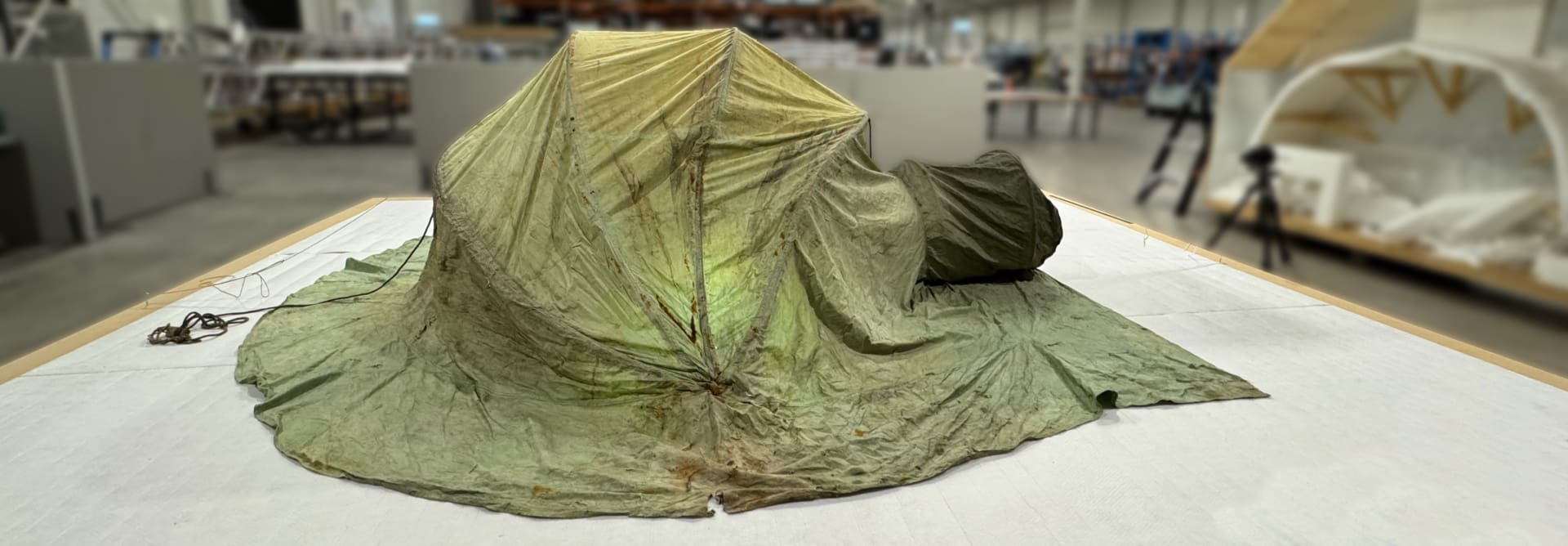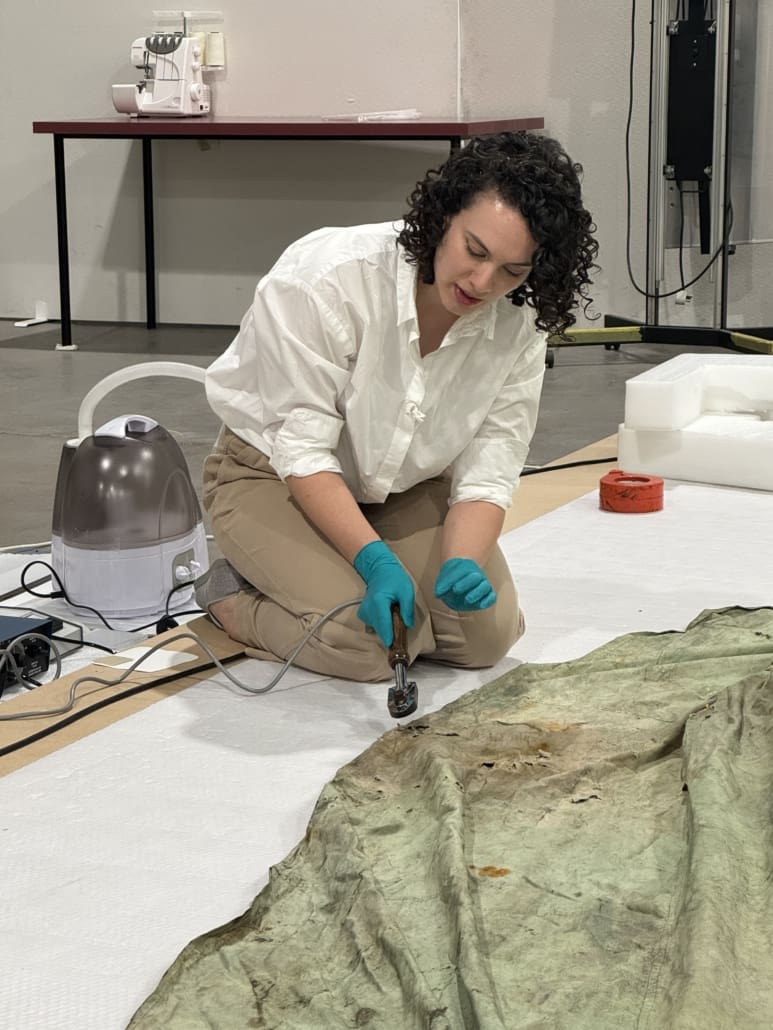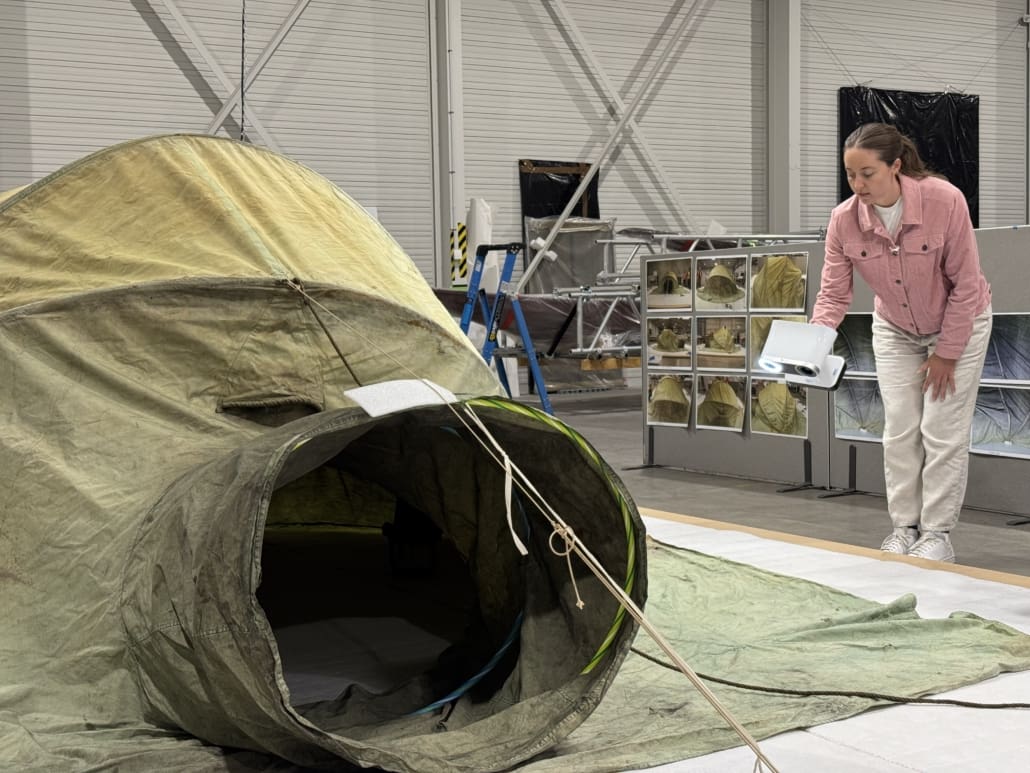Historic Antarctic Tent Gets Special Treatment
Months of detailed conservation of a century old tent from Antarctica is both challenging and delighting specialist conservators.
The tent was one of several commissioned for Sir Ernest Shackleton’s 1914-17 Imperial Trans-Antarctic Expedition, known as the Endurance expedition, and considered by many to be one of the greatest survival stories in history. The distinctive dome shaped tents were designed by expedition member George Marston: some were used by Shackleton’s Weddell Sea Party, and another was in use by Shackleton’s Ross Sea Party, who were tasked with laying crucial food depots towards the polar plateau, which Shackleton planned to collect when he crossed the continent.
The dome tents used in the Weddell Sea were all ultimately lost or destroyed during the expedition, so this tent from the Ross Sea is thought to be the only one left of its kind, with handmade repairs underlining its importance to the expedition.
Originally found at Cape Evans, the tent was brought to the Trust’s New Zealand-based Reserve Collection under permit in the 1980s due to its rarity and condition. Following a significant fundraising campaign in 2024, and with support from Canterbury Museum, the Trust is now working with conservators to coordinate the specialist equipment and facilities required to restore this incredible artefact.
The pale green canvas tent, with metal and timber components, is the focus of careful examination by a team considering all aspects of the tent’s condition now and into the future.
The two key conservation priorities are maintaining the evidence of use and handmade repairs, which tell such evocative stories of the sledging journey, as well as stabilising the heavy corrosion on the metal tent poles. One major challenge is how to re-repair a broken pole to support the weight of the tent fabric.
Canterbury Museum metal conservator Emily Fryer and textile conservator Kate Blair have studied every millimetre of the tent, recording their work on video and in a detailed file of images. They have also used advanced non-invasive technology such as X-ray, PXRF (Portable X-Ray Fluorescence), and SEM (Scanning Electron Microscope) analysis, to give them as much information as possible about the pole structures, metal corrosion, and fabric deterioration as they consider how to proceed.
“We have analysed every aspect of the tent, how the textile and metal components interact, what options we have, and what consequences those options might have,” says Emily.
“I would describe our approach as minimally interventive,” she says. “The tent is generally in really good condition, despite its age and having been under ice and then stored for years. It shows wear and tear from all that, as well as the Ross Sea Party’s travels, soot from their stoves and the repairs made, but many areas of the tent are in amazing condition.”
“We have considered the corrosion and mould we found and are focussed on removing or reducing these damaging elements in small steps, while monitoring how every aspect of our work interacts with the metal and textile.
“We don’t want the tent to look different after this work, so our aim is to stabilise it. Anything we do can be reconsidered at any time, and our records and reports will inform anyone taking another look in future.”
There are several references to the tent in various expedition team diaries, inventories, and in some images taken on the Ice 110 years ago. After a long day of man hauling in gruelling conditions, this tent was a safe haven. The conservators are taking extra care to preserve the original repairs made by the Ross Sea Party, while slowing deterioration as much as possible.
Textile conservator Kate Blair says the conservation could be described as ‘less is more’. “We learned a lot about the tent through very detailed analysis and made decisions based on that. For example, although the tent would benefit from removing corrosion and salts with a wet treatment, we have decided not to do any wet treatments because tests revealed the green dye in the fabric is very water sensitive, meaning any wet treatment would cause huge colour loss”, Kate says.
“We also understand the weight of the fabric being wet would place strain on the weak areas of the fabric, leading to tearing. Instead we have focussed on reducing mould and surface salts through dry-vacuum treatments, and found minimal ways to support rips and tears of the fabric using special adhesive films and support fabric.”
“I have a few more fibres to study under the microscope, especially to understand the Antarctic salt particles in the fabric. Every piece of information is useful and might not change what we do now, but might provide options in the future.”
Kate describes her many hours spent working on the tent as a delight. “Our work is helping this artefact tell its significant story and I feel privileged to be one of very few people to go inside the tent. It is more spacious than you might expect from the outside and working inside is cool and peaceful.”
Recent Inspiring Explorer (Ross Sea 2025) and Canterbury Museum Conservation Technician Louise Piggin is also supporting the project. After visiting Antarctica with the Trust earlier this year, Louise feels she has a much stronger connection to the tent. She says she has more context and can better understand its incredible journey.
Louise is creating a detailed high resolution three-dimensional model of the tent, using a handheld Artec scanner.
“The scanner is used in different ways across various industries, but it is very useful for us to record the surface geometry and texture of the tent. We are capturing the exact dimensions of the tent in three-dimension detail the eye cannot see.”
Trust Heritage Manager Lizzie Meek says this comprehensive and specialised conservation has been made possible by the Trust’s donors and supporters across the world.
“Our supporters are keenly interested in all we do and we are very grateful they help make it happen. They closely follow our Ross Sea Heritage Restoration Project, the world’s largest cold climate heritage programme,” she says.
“Like us, they are fascinated by this tent, its conservation journey, and what will happen next. It’s really important to us to connect the wider international community with the historic sites and incredible objects we care for. We’ll be looking for opportunities to continue to connect people with the tent in future, both digitally and in real life.”
The Trust will be continuing work over the coming months to complete the conservation treatments and looks forward to sharing further updates in early 2026.





